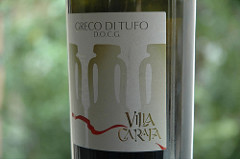WTN: 2003 Villa Carafa Greco di Tufo

Photo by Melissa Schneider.
One thing I like about wine clubs run by good merchants, versus those run by wineries, is that I often get to try wine I've never had before. Usually, prior exposure to similar wines gives me the ability to predict something about the wine before I've tasted it, but every now and then I get something that has little to no context for me, and I get to spend some time rummaging through wine books for information about a previously unknown area.
Like, say, Greco di Tufo, an appellation in Italy's Campania region, not too far from Naples. It's a DOCG, Italy's highest type of appellation, but that's a recent promotion: It was a normal DOC until February 2003. The appellation takes its name from the Greco di Tufo grape, which is just the Greco Bianco grape grown around the town of Tufo. It's an important distinction because Tufo gets its name from the tufa soil underneath it, which also runs through the Touraine region of France's Loire Valley. You probably won't be surprised to learn that the Greeks brought this grape to Italy long ago—there's a reference to it on a fresco in Pompeii—and The Oxford Companion to Wine asserts that it's the progenitor for numerous other white grapes.
But what does it taste like? The wines often have a grapey character, but the 2003 Villa Carafa was like a cold mountain spring: crisp, minerally, and refreshing. You could almost smell the searing acidity, even beyond the citrus aromas. And the minerals! Granite, soapstone, and an almost metallic element. The finish, which leaves a taste of apple must, is on the short side of medium. It's not a wine to cellar but if you like this style it's worth grabbing. (I don't have the price handy, but a quick search puts it around $15 or so)
Like most Italian wines, it shows better with food than on its own. It screams for shellfish, but it went well with chicken legs braised in vermouth.
- The Subjectiveness Of Smell
Slate's Mike Steinberger continues his look at the physiology of tasting wine with a probing of the nose. There's some good information there, and it reinforces what I already tell my students: You are always right about what you smell and what...
- Wtn: 2004 Clos Lapeyre, Jurançon Sec
Jean Bernard Larrieu returned from enology school eager to build a winery on his father's property in the Southwest of France. The farm in the Jurançon region—cuddled up against the Pyrenees—provided the raw material for his new endeavor....
- Wtn: 2003 Unti Zinfandel, Dry Creek Valley
Photo by Melissa Schneider. Critics, for the most part, bemoan the steady increase in alcohol levels in wine. As the alcohol goes up, the drink's ability to pair with food goes down. Zinfandel is the worst offender. Three years ago, getting...
- Wtn: 1998 Nigl Gruner Veltliner, Sentfenberger Piri, Krepmstal, Austria
2003 Nigl Gruner Veltliner, Sentfenberger Piri, Krempstal, Austria When Melissa and I went to the 10-year anniversary tasting for The Age of Riesling, we bought roughly a case of wine. Bill Mayer used the event as a chance to sell off his older inventory,...
- Beaujolais Blanc
I mentioned Beaujolais Blanc in my last post. I've asked around a bit, and few people, even wine geeks, have heard of it, so I thought I'd research it a bit more. When most Americans think of the wines from the Beaujolais region, just south...
